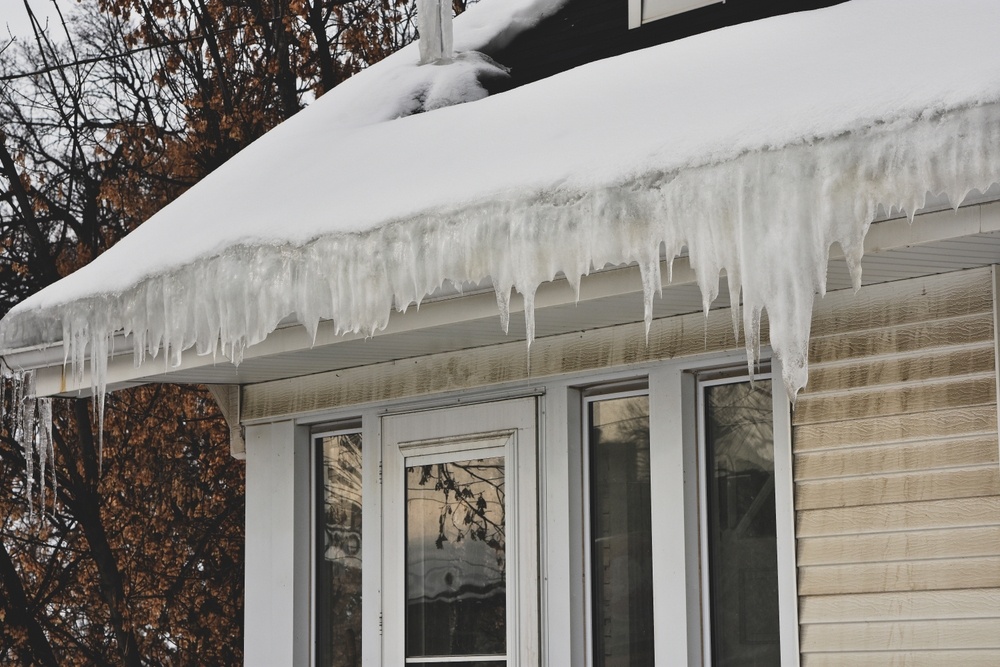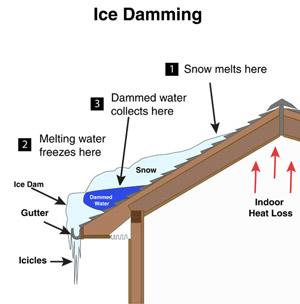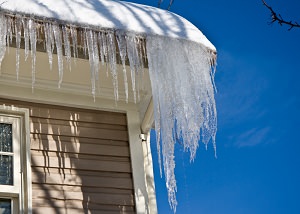How to Prevent Ice Dams on Your Roof and Gutters
Mar 31, 2021How to Prevent Ice Dams on Your Roof and Gutters


Icicles hanging from your eaves may look pretty, but they are a warning sign of ice build-up. This ice build-up can result in what is known as an ice dam. Severe ice dams can weigh hundreds of pounds and compromise the structure of the roof eaves. More severely, they can cause water to back up and leak into your home. If you ignore ice dams, they will only cause more severe and expensive damage later on. Keep in mind that ice dams can affect your gutters, insulation and drywall, paint, and other surfaces in your home.


What Is an Ice Dam?
Simply put, an ice dam is a ridge of ice that accumulates at the edge of your roof during extremely cold weather. This formation prevents melting snow from running off the roof, where it gets stuck at the ice dam.
An ice dam might form when the roof surface temperature is above 32 degrees at its higher-end and below 32 degrees at its lower end. Since heat rises, that heat in your home will rise to your attic and warm the roof surface. Snow on the heated part of the roof melts and flows down until it reaches the part of the roof that is below 32 degrees and then freezes into an ice dam. The dam will grow when it is fed by melting snow above, but the water held by the dam backs up and stays liquid. Eventually, that water will find cracks in the roof covering and flows into the attic, where it can seep through the ceiling and interior walls creating more extreme and expensive problems.
How to Remove an Ice Dam If You’ve Already Got One
If you already have an ice dam, we recommend not chipping away at it, as this can damage your shingles. One way to safely remove an ice dam is to get rid of the snow on the roof. When we say get rid of the snow, this does not mean climbing on your icy roof! Instead, you can use a tool to remove snow from your roof, such as a snow roof rake. Look for one that has a protective buffer so that you don’t damage your shingles and one with a telescoping handle that reaches high enough. Again, please don’t climb on top of your roof and put yourself at risk. That is why we recommend the telescoping handle.
Another way that you can safely remove an ice dam is to warm the eaves. Since ice dams originate in roof valleys and eaves, a popular method is to use an electrical cabling system to boost the temperature of the eaves. An electrical cabling system will heat the eaves just enough to prevent an ice dam from forming.
How to Prevent Ice Dams in the Future
As a homeowner, you’re not helpless when it comes to preventing ice dams. We recommend attacking the root cause, that way, you won’t need to deal with ice dams again in the future (or fork out money for the costly damages they can cause when ignored). There are a few steps you can take to make sure ice dams don’t happen to you, and it all starts with a quality gutter system.
As leaves fall from the trees throughout the year, they will inevitably end up in your gutters. If they don’t get removed frequently, they will cause blockages that won’t allow snowmelt to move through your gutters in the winter. The only problem with regular leaf removal is that northeast Wisconsin is full of beautiful trees that will be losing leaves consistently for months at a time leading up to winter. This means you’ll be spending more time than you’d like cleaning out your gutters in preparation for winter.

To avoid this, consider having a gutter protection system installed on your home to keep these pesky leaves out of your gutters once and for all. Installing a clog-free gutter system during the summer or autumn will prevent any backups of debris and water. Make sure the gutters are securely attached to the home, which should be checked regularly throughout the spring and fall seasons. With a reliable gutter system in place at your home, all snowmelt and moisture will be able to flow freely through your gutters and prevent this dangerous ice buildup during the winter.
Ice dams that build up near the edge of the roof can easily pull gutters down and away from the home, leading to a safety risk for residents, not to mention the damage it can cause to your home and the shrubs below. Ice dams form at the edges of roofs because there’s no heat below it. Keeping the roof the same temperature as the eaves underneath can be achieved through improving your attic’s ventilation, adding more insulation to the attic and sealing up any air leaks that may be present. Excessive warm air leaks heat up the underside of the roof, leading to more melting and pooling.
You lose one-third of your home’s heat through the attic, so inspect your home for leaks, which commonly occur around light fixtures, telephone jacks, doors, windows, access hatches and chimneys. Use caulking and extra insulation to fill these gaps, plus add some ventilation with roof and soffit vents. Heat tape is another option that works well for ice dams. These heat cables are placed along the edge of your roof so ice can’t form in the first place.
Upgrading your home’s insulation will pay for itself many times over in fuel and electricity savings. Additionally, you will have a more comfortable and less drafty house.
Gutter Protection Systems That Work
Snow and ice are an unavoidable part of winters in Wisconsin. You can try to avoid ice dams from forming on your roof, but avoidance will only lead to major headaches for you as a homeowner. If you want to put an end to ice dams, make sure your home is air sealed, properly insulated, and your gutters are clear.
At Keeney Home Services, we specialize in installing GutterShutter® gutters. Unlike many other gutter systems, GutterShutter® is a one-piece seamless gutter system that provides a level of durability and resistance to clogs that you desire. This is important because many homeowners want the convenience of only needing one product to prevent leaves and debris from filling up their gutters year after year. Not only that, but our GutterShutter® seamless gutters are aesthetically appealing and are built on-site to ensure a perfect and flawless fit from side to side of your home.
Request a free estimate today to see about a free heat map analysis and learn more about the different insulation and air sealing options we offer.

